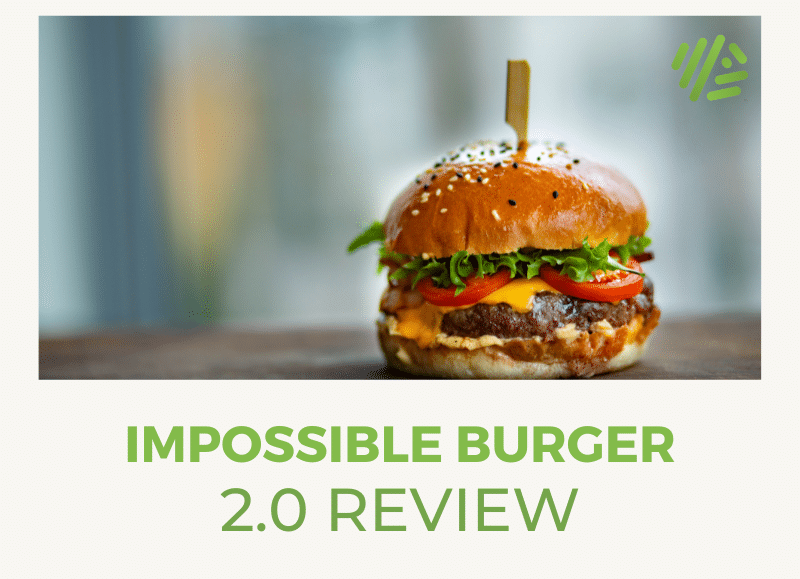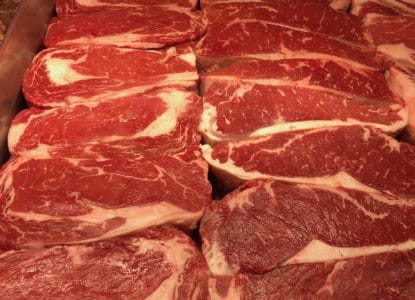Impossible Burger 2.0 Review

Contents
Update: the latest version of the Impossible Burger is now made gluten free without wheat, which is a welcome change. Thanks to our readers for bringing this to my attention.
The Impossible Burger is environmentally friendly, that much cannot be disputed. Raising cattle the way we do does real damage to our planet, and it has to stop, at least at its current trajectory. The industrial farming system is unsustainable, environmentally ruinous, and cruel to both animals and humans alike. Companies like Impossible Foods that create tasty plant based comfort food are badly needed.
However, Vegan junk food is an issue and just because it’s made of plants doesn’t mean it’s good for you.
Impossible burger designed to look like real burger
The Impossible Burger is designed to look and taste just like a real burger. This means the inventors were challenged to use plant matter to make a moist, “bloody” patty, with the same texture as real meat. To be fair, I must admit the Impossible Burger is reminiscent of a real burger, it has a texture and color that looks like ground beef. The aesthetic is impressive. The problem is that it uses ingredients that could be just as bad for some people’s health as eating a real burger every now and again.
In fact, there was some controversy as to whether the FDA would even approve the ingredient, called soy leghemoglobin, that makes the Impossible Burger “bleed.” Soy leghemoglobin releases a protein called heme which gives the burger it’s meat like traits.
Heme is not leghemoglobin
Is soy leghemoglobin safe? Very likely, yes.
The Impossible Burger team did feed unbelievable amounts of soy leghemoglobin to rats and found there were no adverse effects over a 28 day period.1
We don’t have studies in humans to see how people will react to the ingredients in the Impossible Burger.
It’s also worth noting that leghemoglobin, hemoglobin and myoglobin are not the same thing. They might all function to bind oxygen but they do all have a different structure. So, leghemoglobin is not the exact same molecule found in actual meat. They are similar but not identical.
Genetically modified microorganisms
According to this Wired Article, “one acre of soybeans yields just a kilogram of soy leghemoglobin,” so the Impossible Burger team created a workaround.
Wired does a good job of summing up the process:
Technicians take genes that code for the soy leghemoglobin protein and insert them into a species of yeast called Pichia pastoris. They then feed the modified yeast sugar and minerals, prompting it to grow and replicate and manufacture heme with a fraction of the footprint of field-grown soy.
And I do think this is an important distinction to make here. The Impossible Burger doesn’t just use genetically modified ingredients, it produces its key proteins using genetically modified microorganisms. I am not saying that is necessarily a bad thing, it may be a necessary thing in light of what animal agriculture is doing to the environment.
Impossible Burger Ingredients
Update: gluten is no longer an issue. The Impossible Burger 2.0 is now made without gluten.
Water, Soy Protein Concentrate, Coconut Oil, Sunflower Oil, Natural Flavors, 2 percent or less of: Potato Protein, Methylcellulose, Yeast Extract, Cultured Dextrose, Food Starch Modified, Soy Leghemoglobin, Salt, Soy Protein Isolate, Mixed Tocopherols (Vitamin E), Zinc Gluconate, Thiamine Hydrochloride (Vitamin B1), Sodium Ascorbate (Vitamin C), Niacin, Pyridoxine Hydrochloride (Vitamin B6), Riboflavin (Vitamin B2), Vitamin B12.




Most of what is in this article is all myth and misrepresentation. The FDA did not ‘approve’ leghemoglobin because it did not have to. Leghemoglobin has been classified as GRAS (Generally Recognized As Safe) for quite a while now. No testing was necessary.
and the idea that not eating meat is better for the environment is absurd. Growing vegetables is one of the most destructive things there is to an environment. It completely changes the ecosystems in the immediate area and sometimes even for quite a distance. Ranchers do not crop-dust 100s or acres of cows with organophosphates (read ‘nerve gas’), and the only thing livestock puts back into the environment is nitrogen, in the form of manure, and maybe some methane in the air, which occurs naturally anyway (Global Warming nuts really are ridiculous). Nitrogen is good for both the soil and water (algae need it). Pesticides never leave the environment.
Yes, farming is bad for the environment. But what’s worse, eating 400 calories of corn, or eating 400 calories of cow meat that took 6000 calories of corn plus a gallon of water plus other costs to make? Using farmland to feed cattle is so much less efficient than using it to farm human-edible crops. I don’t believe all humans can healthily be meat-free in their diet with current technology, but we should be eating as little meat as possible.
I like the burger but I had multiple reactions to eating. I tried it a 2nd time to confirm it was the burger. I get immediately nauseated and crazy bloating like the stomach flu, diarrhea, vomiting and nothing helped. It has to be an autoimmune response. I eat all kinds of veggie meat including the beyond burger and no trouble. I did advise he company and they actually had a CO and physician contact me to ask about by medical history. But that’s just me…
I thought it was me until i read your comments it absolutley affects me the same way
Did you happen to come across or ask who, what, where in regards to the “Natural Flavor” ingredient?
I am unable to search for any real break down of what this mystery ingredient is.
Who produces it for them?
What is in this ingredient?
What is the source of this ingredient?
My spit is “natural” and a chemist could break down what is in my “natural” occurring spit and I could then provide the breakdown.
Most if not all the time it is under Trademark secret so then no one is allowed to question it either.
If a company is presumably being transparent about its products production and ingredients they should by all means be more than willing to disclose this information whenever asked.
Hmmm…I suppose the next step is to call the company and just ask.
Is this an article about saving the planet or perhaps for a bunch of people who are allergic to everything? I’m confused? Also, I’m tired of the conflation of being meat free being associated with the environment and allergies. People choose to not eat meat because they are empathic and ethical.
I’ve eaten the Impossible Burger numerous times at Arooga’s. It’s a nice alternative when I go out to eat with my daughter. She’s a vegan, i’m not. But I am trying to cut down on meat, mainly because of personal beliefs regarding the destruction of our environment caused by factory meat farming. I do it for myself. If there are health benefits that come with that choice (there are), then better yet. Personally, I think it’s great that it tastes like meat. NOBODY I know has had any kind of adverse reaction to this product. The worst reaction is when they say it tastes like crap once they find out it isn’t really meat. Looking forward to the Burger King in my area to start selling this product.
This piece is equal parts ignorant and lazy. This site must be for people who use health advice to attention seek, otherwise you’d have to include some actual information in your articles. Maybe learn something before engaging in moronic fear-monger speculation about a product with the potential to do a lot of good.
I ordered the meatless burger tonight from A & W and I had very immediate reactions. My stomach bloated out like I was 5 months pregnant, I became ill, stabbing stomach pain and have been experiencing constant diarrhea. I feel absolutely terrible and will never consume this product again. I will be contacting the company as this is not safe for customers to be consuming. No food should produce these results and I have eaten Harvey’s veggie burgers for years so it’s something specific in this product. Absolutely disgusted.
If Bill Gates is behind this, stop eating it immediately.
Yep! Remember, his “agenda” is to help the world population go down to 500,000,000 and this burger is suddenly showing up everywhere now. Hey maybe it’s gonna be the new “Soylent Green” they already have the “Soylent” drink! lol.. I’ve had this burger before at Bareburger and white castle (same taste, except bareburger costs more and puts a bunch of “Veggie” stuff on top of it) it’s not bad, but take away the bread and condiments it just tastes like an overly “smoked” “meat like” substance. Don’t try to eat it cold, that’s when it really reveals itself as an imitation.
Whoa, I want to learn more about BG’s agenda. Where can I subscribe to your newsletter?
The same places all the other nut jobs get their alt-facts from: infowars (i.e. alex jones) who surprise surprise, sells the most ludicrous brain-enhancing supplements.
I am 100% vegan. So is my wife. So what’s my 19 year old daughter. All of us enjoy an impossible burger from time to time; sometimes a beyond burger. None of us have ever had any type of reaction. None of what I read in this article is based in science.
The ingredients are anything but healthy. Eat real food. Period.
They must be unhealthy because someone on the internet said so.
This is simple. If you are interested in saving the planet, try Impossible burger 2.0. If it doesn´t taste good or makes you sick, stop! How difficult is that? “Better a diamond with a flaw than a pebble without.” — Confucius,
I could have saved them 80 million dollars. My wife and I own a very successful vegetarian and organic take out restaurant. Food companies have tried to sell us meat substitute products for years and they all fail for the same reason – vegetarians and especially vegans DON’T WANT ANYTHING THAT TASTES OR LOOKS LIKE MEAT! It’s like telling a kid that hates broccoli that it’s not really broccoli – it just looks and tastes like it. Let me save you even more money – expensive campaigns to write fake reviews and flood social media with how great it is won’t work. You missed the most basic fundamental point – meat eaters want meat and vegetarians don’t. Why is that so hard?
this vegan does so glad they didn’t take your advice!
This product is probably aimed at environmentally conscious meat eaters. They want to eat something like meat but don’t want to damage the environment by raising cows that will generate a lot of methane.
Yep, good for you for owning a restaurant but your whole post is garbage, proven by the simple reality that the products are selling well.
The impossible burger is amazing. I ate two per day for almost a year now, and it raised my b vitamin level and red blood cell count to normal when it used to be low from being vegetarian without eating much B. The impossible burger makes me feel incredible like I’ve just been shot with B vitamins. It tastes just like meat but no cholesterol and no animals dying. I don’t have a gluten allergy so I say bring on the gluten and bring on the Heme that makes it taste like meat. I’m sorry but beets do NOT taste like meat. So that’s why I don’t like the beyond burger as much as the impossible burger. Texture, smell, amd everything is far better on the impossible burger. I am alive and have been to the doctor twice this year for a checkup and to run the numbers. It was truly astounding how much healthier I became from eating the impossible burger. Call me the lab test for humans. I’ve eaten more of it than they would give me in an experiment. So here os your living proof that the burger is Grade A Awesome and has zero side effects for the average person…unless addiction is a side effect. I am obsessed with this burger. I’m basically on a personal mission to find the best one. I’ve had it as burgers, tacos, meatballs and spaghetti, and over mashed potatoes in a sage butter sauce. I wish more restaurants would try different ways of cooking with it. That way, I won’t be bored with having the same thing all the time. Btw, my meat eating family said it was better than an in n out burger.
Holy cow. Cut the enthusiasm by 50% and you could possibly pass for a real comment. If this was meant to be satire, you didn’t go far enough.
If it I proved your health it was by eliminating the bad food you were eating before. Eat what let food. And be healthy.
Just because something tastes good does not mean it is good.
One needs to be really crazy to eat something named “impossible” it is just s challlenge to people’s ego and their “ wisdom” ?
When it comes to foods, bottomline FDA does NOT approve anything, all they do is to issue a Letter of no objection””
Yes, it us GMO,.
Where is Proposition 65 position in this ?
The main issue is not the makers of the “IMPOSSIBLE “ burger, it is the consumers that consume it ! Do rhey read the label? Do they research and make a wise decision about how to protect their bodies? Or is it a fashion statement?
Since I read the book ONE by Fer Na, i just can’t understand the kind of “unconscious “ suicidal behavior people have by not reading the labels if what they eat.
Darn!
Why didn’t the marketing team call the burger “A humble offering to humanity’s vaulting ego”
How dare we challenge GOD with this meaty tower of babel?
I’m vegan and I ate the Impossible Burger three days ago and I’m still paying for it. My husband said I might have to see my doctor as I am still having terrible gut issues and can’t pass any food normally yet with awful pain in my gut. I don’t know if it’s an allergic reaction or yeast buildup but I can’t continue this way. I’m so angry that the company is allowed to sell this gmo crap! I’m just hoping I fully recover from it soon.
Thanks John me and my husband Phil stopped off at fatburgers and order the impossible burger, after eating them we began to experience stomach aches, heart burn, and feeling like crap. I guess the name imposible burger should have made my better judgement kick it that it was to good to be true, I must admit like most foods that are bad for you it, taste good going down until it starts coming up again… warning the imposible burger is just another way to scam people like us! who are looking for healthy alternatives. It’s worse than eating hotdogs! My last hotdog was in 1996 and today was my last imposible burger🤪
Additionally, as founder of a company and website aimed at improving health through nutrition and genetics (an idea I think is wonderful if properly executed) you should not be “wondering out loud” and inciting fear in you readers if you do not explain any credible science backing up your imigaination.
Alyssa, I think the author of the article answered you pretty clearly. He seemed to know a lot more than you.
As a reminder: 1. Many foods we regularly consume contain live and dead forms of yeast (baker’s yeast in baked goods and bread, yogurt, alcohols, nutritional yeast). When one consumes these foods you are consuming THOUSANDS of yeast derived proteins…. There is absolutely nothing wrong with eating yeast. 2. Any yeast that is used in food production is NOT a pathogenic species of yeast. The yeast used to make this soy protein is not the same species as Canida albicans. 3. Yeast proteins in the diet do not cause Candida Albicans infections or contribute to them. Yeast thrive on sugars and their metabolic breakdown products, not on other yeast proteins. 4. As Jak mentioned above, the soy protein you mention is going to be in the exact same form in a yeast cell as it would be in the soy bean. If the gene originally came from a soy plant, then the DNA is exactly the same, which is transcribed into exactly the same RNA, and translated into exactly the same sequence of amino acids that make up the soy protein. Scientific research consistently uses yeast as a model organism to study basic cell processes, such as DNA repair, and scientist express human versions of proteins in the yeast, where they function exactly as they do in human cells (https://www.yourgenome.org/stories/using-yeast-in-biology). This soy leghemoglobin would be no exception. 5. Additionally, millions of type-1 diabetic patients take insulin that is produced in yeast and bacteria, and they are not all dying from candida albicans infections: https://www.dnalc.org/view/15929-How-insulin-is-made-using-yeast.html (this is just one example)
John, could you please explain to me what this “GMO yeast soy byproduct” is if it is not the soy leghemoglobin mentioned above in the article and me comment. And then please explain to me how it is potentially harmful compared to eating yeast themselves as I mentioned above. And please explain why you think GMOs are harmful to health to begin with, because to my knowledge they do not harm human health (the environment and financial success of farmers is another story).
I never said eating yeast was harmful. However, Pichia pastoris has not previously been used to make human food, which Impossible Foods note in their paper: https://www.ncbi.nlm.nih.gov/pmc/articles/PMC5813221/
I just ate half an impossible burger and had to stop because of the immediate allergic reaction; hot, intense flushing (almost purple) of my face. I found this post after googling “adverse reactions to food additive gene.” In addition, to other articles, this post helped me to confirm that I was reacting to heme, I went to speak with the good vendor and they were completely misled about the ingredients and how they were produced. They thought the product was completely organic and that all ingredients were “naturally produced and occurring in nature.”
Just as a reminder, there is heme in your own body. If you were allergic to it, you could not carry oxygen, and you would be dead.
Leghemoglobin, hemoglobin and myoglobin are not the same thing. They might all function to bind oxygen but they do all have a different structure. They are different proteins and people could be allergic to leghemoglobin, although it is thought to be not very immunogenic (i.e. it is unlikely to cause an immune response).
Alyssa, you are so dumb. Keep your nonsense to yourself.
this is utterly insane. it’s the exact same molecule as heme found in actual meat which is completely safe. how it’s produced doesn’t matter at all. that being said, the impossible burger is also disgusting. the aftertaste is awful.
You’re right. Author is scientifically illiterate.